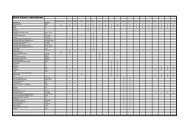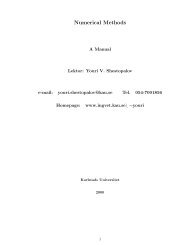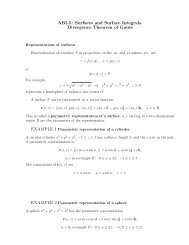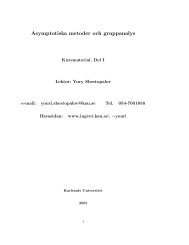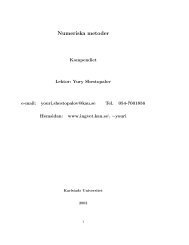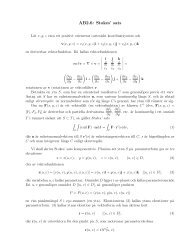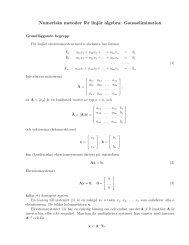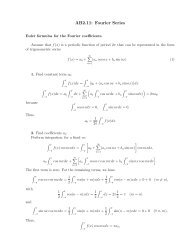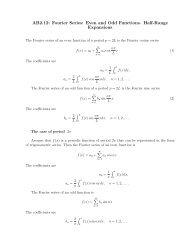14.2 Generalized potentialsLet S Π (Γ) ∈ R 2 be a domain bounded by the closed piecewise smooth contour Γ. We assumethat a rectilinear interval Γ 0 is a subset of Γ, so that Γ 0 = {x : y = 0, x ∈ [a, b]}.Let us say that functions U l (x) are the generalized single layer (SLP) (l = 1) or double layer(DLP) (l = 2) potentials ifwhere∫U l (x) = K l (x, t)ϕ l (t)dt,Γx = (x, y) ∈ S Π (Γ),K l (x, t) = g l (x, t) + F l (x, t) (l = 1, 2),g 1 (x, t) = g(x, y 0 ) = 1 π ln 1|x − y 0 | , g 2(x, t) = ∂∂y 0g(x, y 0 ) [y 0 = (t, 0)],F 1,2 are smooth functions, and we shall assume that for every closed domain S 0Π (Γ) ⊂ S Π (Γ),the following conditions holdi) F 1 (x, t) is once continuously differentiable with respect to thevariables of x and continuous in t;ii) F 2 (x, t) andare continuous.F 1 2 (x, t) = ∂ ∂y∫tqF 2 (x, s)ds, q ∈ R 1 ,We shall also assume that the densities of the generalized potentials ϕ 1 ∈ L (1)2 (Γ) andϕ 2 ∈ L (2)2 (Γ), where functional spaces L (1)2 and L (2)2 are defined in Section 3.15 Reduction of boundary value problems to integralequationsGreen’s formulas show that each harmonic function can be represented as a combination ofsingle- and double-layer potentials. For boundary value problems we will find a solution in theform of one of these potentials.Introduce integral operators K 0 and K 1 acting in the space C(Γ) of continuous functionsdefined on contour Γand∫K 0 (x) = 2Γ∫K 1 (x) = 2Γ∂Φ(x, y)∂n yϕ(y)dl y , x ∈ Γ (295)∂Φ(x, y)∂n xψ(y)dl y , x ∈ Γ. (296)The kernels of operators K 0 and K 1 are continuous on Γ As seen by interchanging the orderof integration, K 0 and K 1 are adjoint as integral operators in the space C(Γ) of continuousfunctions defined on curve Γ.56
Theorem 36 The operators I − K 0 and I − K 1 have trivial nullspacesN(I − K 0 ) = {0}, N(I − K 1 ) = {0}, (297)The nullspaces of operators I + K 0 and I + K 1 have dimension one andwithN(I + K 0 ) = span {1}, N(I + K 1 ) = span {ψ 0 } (298)∫Γψ 0 dl y ≠ 0. (299)Proof. Let φ be a solution to the homogeneous integral equation φ − K 0 φ = 0 and define adouble-layer potential∫∂Φ(x, y)v(x) =ϕ(y)dl y , x ∈ D (300)∂n yΓwith a continuous density φ. Then we have, for the limiting values on Γ,∫∂Φ(x, y)v ± (x) =ϕ(y)dl y ± 1 ϕ(x) (301)∂n y 2which yieldsΓ2v − (x) = K 0 ϕ(x) − ϕ = 0. (302)From the uniqueness of the interior Dirichlet problem (Theorem 33) it follows that v = 0 in thewhole domain D. Now we will apply the contunuity of the normal derivative of the double-layerpotential (300) over a smooth contour Γ,∂v(y)∂n y∣ ∣∣∣∣+− ∂v(y)∂n y∣ ∣∣∣∣−= 0, y ∈ Γ, (303)where the internal and extrenal limiting values with respect to Γ are defined as followsand∣∂v(y) ∣∣∣∣− ∂v(y)= lim∂n y y→Γ, y∈D ∂n y∣∂v(y) ∣∣∣∣+ ∂v(y)= lim∂n y y→Γ, y∈R 2 \ ¯D ∂n yNote that (303) can be written asFrom (304)–(306) it follows that= limh→0n y · grad v(y − hn y ) (304)= limh→0n y · grad v(y + hn y ). (305)lim n y · [grad v(y + hn y ) − grad v(y − hn y )] = 0. (306)h→0∂v(y)∂n y∣ ∣∣∣∣+− ∂v(y)∂n y∣ ∣∣∣∣−= 0, y ∈ Γ. (307)Using the uniqueness for the exterior Neumann problem and the fact that v(y) → 0, |y| → ∞,we find that v(y) = 0, y ∈ R 2 \ ¯D. Hence from (301) we deduce ϕ = v + − v − = 0 on Γ. ThusN(I − K 0 ) = {0} and, by the Fredholm alternative, N(I − K 1 ) = {0}.57
- Page 1 and 2:
Karlstad UniversityDivision for Eng
- Page 3 and 4:
10.5 The Hilbert-Schmidt theorem .
- Page 5 and 6: 2 Notion and examples of integral e
- Page 7 and 8: Subtracting termwise we obtain an o
- Page 9 and 10: with the initial conditiony(x 0 ) =
- Page 11 and 12: Example 7 The space C[a, b] of cont
- Page 13 and 14: where the kernel K(x, y) is a conti
- Page 15 and 16: and so on, obtaining for the (n + 1
- Page 17 and 18: Thus the common term of the series
- Page 19 and 20: Proof. To prove the theorem, it is
- Page 21 and 22: Theorem 9 (Superposition principle)
- Page 23 and 24: A, being completely continuous in t
- Page 25 and 26: These conditions are equivalent to
- Page 27 and 28: In particular, if λ is a regular v
- Page 29 and 30: so thatanda 11 =a 12 =a 21 =a 22 =f
- Page 31 and 32: Therefore the solution isφ(x) = f(
- Page 33 and 34: ∫ bc n = . . .a∫ ba∣K(y 1 , y
- Page 35 and 36: is called the Euclidian space.In a
- Page 37 and 38: Now note that K N (x, y) in (189) i
- Page 39 and 40: Proof. Assume that y n ∈ Im T and
- Page 41 and 42: We see that, on the one hand, vecto
- Page 43 and 44: Multiply equality (213) by ¯φ 0 a
- Page 45 and 46: Replacing x by y abd vice versa, we
- Page 47 and 48: 12 Harmonic functions and Green’s
- Page 49 and 50: Since on Ω(x, r) we havegrad y Φ(
- Page 51 and 52: From Green’s first formula applie
- Page 53 and 54: which proves the continuity of the
- Page 55: where B 1 is a constant taken accor
- Page 59 and 60: Theorem 41 Let D ∈ R 2 be a domai
- Page 61 and 62: n = 2 π∫1−1f(x)U n (x) √ 1
- Page 63 and 64: A similar statement is valid for th
- Page 65 and 66: In some cases one can determine the
- Page 67 and 68: Coefficient a 0 vanishes because (s
- Page 69 and 70: Expand the right-hand side in the C
- Page 71 and 72: We see that the equation has the un
- Page 73 and 74: or, in other notation,andorL = {l n
- Page 75 and 76: where T n (x) = cos(n arccos x) are
- Page 77 and 78: and the integral equationwhereΦ N
- Page 79 and 80: Let us expand the functiong(s) = 1l
- Page 81 and 82: Assume that X n and Y n are the spa



